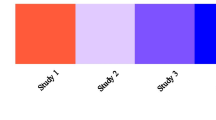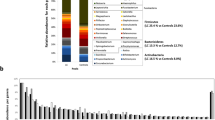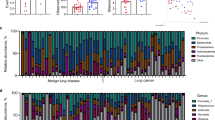Abstract
The purpose of this study is to identify the characteristics of microbial communities in the lung cancer tissues from patients in Kunming sity of southwestern China and to compare the microbial differences at different clinical stages of lung cancer to uncover potential microbial biomarkers. In total, 40 tissue samples of primary lung adenocarcinoma were collected and further performed by 16S rRNA gene sequencing. The subjects were grouped according to TNM stages (T and N group), clinical stage, and smoke status, and the microbial differences in each group were compared. Analysis of sequence data to determine beta diversity, the UniFrac distance was calculated by QIIME and visualized by principal coordinate analysis (PCoA) using R (version 2.15.3). Microbiome abundance and diversity between different groups were calculated by t test or Wilcoxon rank sum test and drawn by R. The linear discriminant analysis effect size (LEfSe) method was utilized to compare relative abundances of all bacterial taxa between groups. A total of 951 OTUs were identified in the cancer tissues. No significant difference has been found in the alpha diversity within all the groups. Beta diversity significantly differed in the N, T, and clinical stage groups. By LEfSe analysis, eight differential taxa including Bifidobacterium were identified in the N group. In the T1 and T2 group, the LEfSe result identified five phyla and ten genera. The differential genera were Moraxella, Dolosigranulum, unidentified_Corynebacteriaceae, and Citrobacter in the T2 group and Bifidobacterium, Alistipes, Akkermansia, Blautia, Lactobacillus, as well as Faecalibaculum in the T1 group. Differential bacterial composition and abundance were also observed in the clinical stage group. This study confirmed that by 16S rRNA sequencing, we identified the dominant microbe of lung cancer tissue in different groups. Bifidobacterium may play an essential role in lymph node metastasis and tumor progression, providing a specific potential microbial biomarker for lung adenocarcinoma. PCR products were subject to vertical electrophoresis on 2% agarose gels, and a colloid recovery kit (Qiagen, Valencia, CA) was applied to recover the target bands. Libraries were generated by the TruSeq DNA PCR-Free Sample Preparation Kit (Illumina, San Diego, USA), and the concentrations were quantitated with a Qubit fluorometer. Finally, the qualified libraries were sequenced by NovaSeq6000 (Illumina).






Similar content being viewed by others
Data availability
Not applicable.
References
Alipour M (2021) Molecular mechanism of helicobacter pylori-induced gastric cancer. J Gastrointest Cancer 52(1):23–30. https://pubmed.ncbi.nlm.nih.gov/32926335/
Bender JM, Li F, Adisetiyo H, Lee D, Zabih S, Hung L, Wilkinson TA, Pannaraj PS, She RC, Bard JD, Tobin NH, Aldrovandi GM (2018) Quantification of variation and the impact of biomass in targeted 16S rRNA gene sequencing studies. Microbiome 6:155. https://pubmed.ncbi.nlm.nih.gov/30201048/
Burns MB, Lynch J, Starr TK, Knights D, Blekhman R (2015) Virulence genes are a signature of the microbiome in the colorectal tumor microenvironment. Genome Med 7:55. https://pubmed.ncbi.nlm.nih.gov/26170900/
D’Journo XB, Bittar F, Trousse D, Gaillat F, Doddoli C, Dutau H, Papazian L, Raoult D, Rolain JM, Thomas PA (2012) Molecular detection of microorganisms in distal airways of patients undergoing lung cancer surgery. Ann Thorac Surg 93:413–422. https://pubmed.ncbi.nlm.nih.gov/22206956/
Davis NM, Proctor DM, Holmes SP, Relman DA, Callahan BJ (2018) Simple statistical identification and removal of contaminant sequences in marker-gene and metagenomics data. Microbiome 6:226. https://pubmed.ncbi.nlm.nih.gov/30558668/
Dwivedi M, Powali S, Rastogi S, Singh A, Gupta DK (2021) Microbial community in human gut: a therapeutic prospect and implication in health and diseases. Lett Appl Microbiol 73(5):553–568. https://pubmed.ncbi.nlm.nih.gov/34365651/
Esaiassen E, Hjerde E, Cavanagh JP, Simonsen GS, Klingenberg C, Norwegian Study Group on Invasive Bifidobacterial I (2017) Bifidobacterium bacteremia: clinical characteristics and a genomic approach to assess pathogenicity. J Clin Microbiol 55:2234–2248. https://pubmed.ncbi.nlm.nih.gov/28490487/
Fábián K, Németh Z, Furák J, Tiszlavicz L, Pápay J, Krenács T, Tímár J, Moldvay J (2014) Protein expression differences between lung adenocarcinoma and squamous cell carcinoma with brain metastasis. Anticancer Res 34:5593–5597. https://pubmed.ncbi.nlm.nih.gov/25275061/
Galazzo G, van Best N, Benedikter BJ, Janssen K, Bervoets L, Driessen C, Oomen M, Lucchesi M, van Eijck PH, Becker HEF, Hornef MW, Savelkoul PH, Stassen FRM, Wolffs PF, Penders J (2020) How to count our microbes? The effect of different quantitative microbiome profiling approaches. Front Cell Infect Microbiol 10:403. https://pubmed.ncbi.nlm.nih.gov/32850498/
Geerlings SY, Kostopoulos I, de Vos WM, Belzer C (2018) Akkermansia muciniphila in the human gastrointestinal tract: when, where, and how? Microorganisms 6(3):75. https://pubmed.ncbi.nlm.nih.gov/30041463/
Greathouse KL, White JR, Vargas AJ, Bliskovsky VV, Beck JA, von Muhlinen N, Polley EC, Bowman ED, Khan MA, Robles AI, Cooks T, Ryan BM, Padgett N, Dzutsev AH, Trinchieri G, Pineda MA, Bilke S, Meltzer PS, Hokenstad AN, Stickrod TM, Walther-Antonio MR, Earl JP, Mell JC, Krol JE, Balashov SV, Bhat AS, Ehrlich GD, Valm A, Deming C, Conlan S, Julia O, Segre JA, Harris CC (2018) Interaction between the microbiome and TP53 in human lung cancer. Genome Biol 19:123. https://pubmed.ncbi.nlm.nih.gov/30143034/
Howe C, Kim SJ, Mitchell J, Im E, Kim YS, Kim YS, Rhee SH (2018) Differential expression of tumor-associated genes and altered gut microbiome with decreased Akkermansia muciniphila confer a tumor-preventive microenvironment in intestinal epithelial Pten-deficient mice. Biochim Biophys Acta Mol Basis Dis 1864:3746–3658. https://pubmed.ncbi.nlm.nih.gov/30292635/
Huang YJ, Sethi S, Murphy T, Nariya S, Boushey HA, Lynch SV (2014) Airway microbiome dynamics in exacerbations of chronic obstructive pulmonary disease. J Clin Microbiol 52:2813–2823. https://pubmed.ncbi.nlm.nih.gov/24850358/
Huang D, Xiaofang S, Yuan M, Zhang S, He J, Deng Q, Qiu W, Dong H, Cai S (2019) The characterization of lung microbiome in lung cancer patients with different clinicopathology. Am J Cancer Res 9:2047–2063
Lee SH, Sung JY, Yong D, Chun J, Kim SY, Song JH, Chung KS, Kim EY, Jung JY, Kang YA, Kim YS, Kim SK, Chang J, Park MS (2016) Characterization of microbiome in bronchoalveolar lavage fluid of patients with lung cancer comparing with benign mass like lesions. Lung Cancer 102:89–95. https://pubmed.ncbi.nlm.nih.gov/27987594/
Lérias JR, Paraschoudi G, de Sousa E, Martins J, Condeço C, Figueiredo N, Carvalho C, Dodoo E, Castillo-Martin M, Beltrán A, Ligeiro D, Rao M, Zumla A, Maeurer M (2019) Microbes as master immunomodulators: immunopathology, cancer and personalized immunotherapies. Front Cell Dev Biol 7:362. https://pubmed.ncbi.nlm.nih.gov/32039196/
Nejman D, Livyatan I, Fuks G, Gavert N, Zwang Y, Geller LT, Rotter-Maskowitz A, Weiser R, Mallel G, Gigi E, Meltser A, Douglas GM, Kamer I, Gopalakrishnan V, Dadosh T, Levin-Zaidman S, Avnet S, Atlan T, Cooper ZA, Arora R, Cogdill AP, Khan Md AW, Ologun G, Bussi Y, Weinberger A, Lotan-Pompan M, Golani O, Perry G, Rokah M, Bahar-Shany K, Rozeman EA, Blank CU, Ronai A, Shaoul R, Amit A, Dorfman T, Kremer R, Cohen ZR, Harnof S, Siegal T, Yehuda-Shnaidman E, Gal-Yam EN, Shapira H, Baldini N, Langille MGI, Ben-Nun A, Kaufman B, Nissan A, Golan T, Dadiani M, Levanon K, Bar J, Yust-Katz S, Barshack I, Peeper DS, Raz DJ, Segal E, Wargo JA, Sandbank J, Shental N, Straussman R (2020) The human tumor microbiome is composed of tumor type-specific intracellular bacteria. Science 368:973–980. https://pubmed.ncbi.nlm.nih.gov/32467386/
Parker BJ, Wearsch PA, Veloo ACM, Rodriguez-Palacios A (2020) The genus Alistipes: gut bacteria with emerging implications to inflammation, cancer, and mental health. Front Immunol 11:906. https://pubmed.ncbi.nlm.nih.gov/32582143/
Poore GD, Kopylova E, Zhu Q, Carpenter C, Fraraccio S, Wandro S, Kosciolek T, Janssen S, Metcalf J, Song SJ, Kanbar J, Miller-Montgomery S, Heaton R, Mckay R, Pravin Patel S, Swafford AD, Knight R (2020) Microbiome analyses of blood and tissues suggest cancer diagnostic approach. Nature 579:567–574. https://pubmed.ncbi.nlm.nih.gov/32214244/
Routy B, Le Chatelier E, Derosa L, Duong CPM, Alou MT, Daillère R, Fluckiger A, Messaoudene M, Rauber C, Roberti MP, Fidelle M, Flament C, Poirier-Colame V, Opolon P, Klein C, Iribarren K, Mondragón L, Jacquelot N, Bo Q, Ferrere G, Clémenson C, Mezquita L, Masip JR, Naltet C, Brosseau S, Kaderbhai C, Richard C, Rizvi H, Levenez F, Galleron N, Quinquis B, Pons N, Ryffel B, Minard-Colin V, Gonin P, Soria J-C, Deutsch E, Loriot Y, Ghiringhelli F, Zalcman G, Goldwasser F, Escudier B, Hellmann MD, Eggermont A, Raoult D, Albiges L, Kroemer G, Zitvogel L (2018) Gut microbiome influences efficacy of PD-1-based immunotherapy against epithelial tumors. Science 359:91–97. https://pubmed.ncbi.nlm.nih.gov/29097494/
Sivan A, Corrales L, Hubert N, Williams JB, Aquino-Michaels K, Earley ZM, Benyamin FW, Lei YM, Jabri B, Alegre M-L, Chang EB, Gajewski TF (2015) Commensal Bifidobacterium promotes antitumor immunity and facilitates anti-PD-L1 efficacy. Science 350:1084–1089. https://pubmed.ncbi.nlm.nih.gov/26541606/
Wang J, Song J, Gao Z, Huo X, Zhang Y, Wang W, Qi J, Zheng S (2017) Analysis of gene expression profiles of non-small cell lung cancer at different stages reveals significantly altered biological functions and candidate genes. Oncol Rep 37:1736–1746. https://pubmed.ncbi.nlm.nih.gov/28098899/
Weber E, Reynaud Q, Suy F, Gagneux-Brunon A, Carricajo A, Guillot A, Botelho-Nevers E (2015) Bifidobacterium species bacteremia: risk factors in adults and infants. Clin Infect Dis 61:482–484. https://pubmed.ncbi.nlm.nih.gov/25921690/
Wu BG, Segal LN (2018) The Lung Microbiome and Its Role in Pneumonia. Clin Chest Med 39:677–689. https://pubmed.ncbi.nlm.nih.gov/30390741/
Yan X, Yang M, Liu J, Gao R, Jihong H, Li J, Zhang L, Shi Y, Guo H, Cheng J, Razi M, Pang S, Xiaowei Y, Shen H (2015) Discovery and validation of potential bacterial biomarkers for lung cancer. Am J Cancer Res 5:3111–22. https://pubmed.ncbi.nlm.nih.gov/26693063/
Yu G, Gail MH, Consonni D, Carugno M, Humphrys M, Pesatori AC, Caporaso NE, Goedert JJ, Ravel J, Landi MT (2016) Characterizing human lung tissue microbiota and its relationship to epidemiological and clinical features. Genome Biol 17:163. https://pubmed.ncbi.nlm.nih.gov/27468850/
Zhang Y, Ren J-S, Huang H-Y, Shi J-F, Li N, Zhang Y, Dai M (2018) International trends in lung cancer incidence from 1973 to 2007. Cancer Med 7:1479–1489. https://pubmed.ncbi.nlm.nih.gov/29542259/
Zhu S, Zhao Y, Bao Y, Cui Y, Zhu X, He X, Ye M, Chen X (2020) Characteristics of microbiome in lung adenocarcinoma tissue from patients in southwestern China. Res Square. https://doi.org/10.21203/rs.3.rs-46069/v1
Zou M, Yang Z, Fan Y, Gong L, Han Z, Ji L, Hu X, Wu D (2022) Gut microbiota on admission as predictive biomarker for acute necrotizing pancreatitis. Front Immunol 13:988326. https://doi.org/10.3389/fimmu.2022.988326
Acknowledgements
We sincerely thank Hangzhou Lianhe Medical Laboratory Co., LTD, for providing the help in 16S rRNA sequencing and results interpretation.
Funding
This study was supported by the Yunnan Provincial Department of Science and Technology-Kunming Medical University Applied Basic Research Project [No.202001AY070001-025].
Author information
Authors and Affiliations
Contributions
Sinuo Song and Xiaobo Chen designed the study and drafted the manuscript. Yunping Zhao and Yanan Bao collected the patients’ samples and clinical information. Xuan He and Duozhi Shi performed the 16S rRNA sequencing. Yue Cui and Xingming Zhu analyzed the OTU data. All the authors read and approved the final manuscript.
Corresponding author
Ethics declarations
Ethical approval
The authors are accountable for all aspects of the work in ensuring that questions related to the accuracy or integrity of any part of the work are appropriately investigated and resolved. The study was conducted in accordance with the Declaration of Helsinki (as revised in 2013). The study was approved by the Medical Ethics Committee of The First Affiliated Hospital of Kunming Medical University Kunming(Code:HKMU20180532). All the subjects have signed informed consent for inclusion before participating in the study.
Consent to participate
Not applicable.
Consent for publication
All the authors have approved the manuscript for publication.
Competing interests
The authors declare no competing interests.
Preprint statement
A preprint has been published earlier [https://doi.org/10.21203/rs.3.rs-46069/v1].
Additional information
Responsible Editor: Lotfi Aleya
Publisher's note
Springer Nature remains neutral with regard to jurisdictional claims in published maps and institutional affiliations.
Rights and permissions
Springer Nature or its licensor (e.g. a society or other partner) holds exclusive rights to this article under a publishing agreement with the author(s) or other rightsholder(s); author self-archiving of the accepted manuscript version of this article is solely governed by the terms of such publishing agreement and applicable law.
About this article
Cite this article
Chen, M., Cui, Y., Liu, C. et al. Characteristics of the microbiome in lung adenocarcinoma tissue from patients in Kunming city of southwestern China. Environ Sci Pollut Res 30, 49992–50001 (2023). https://doi.org/10.1007/s11356-023-25528-1
Received:
Accepted:
Published:
Issue Date:
DOI: https://doi.org/10.1007/s11356-023-25528-1




